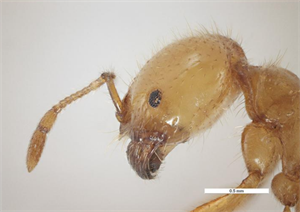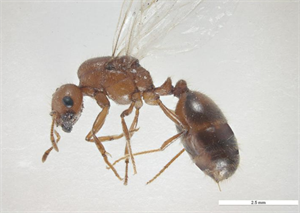- Worldwide distribution. Common in many Pacific island countries. Ground-nesting in sunny agricultural, forestry, grassland areas. Aggressive, painful sting. Among world's 100 worse invasive species.
- Nests slightly raised mounds, radiating below surface. Many hundreds per ha. Eats seeds, other insects, reptiles, amphibians, honeydew.
- Direct damage to seeds, plant parts, hoses, loss of biodiversity; indirectly by defending aphids, mealybugs, scales and whiteflies from natural enemies.
- Queens, males and three types of worker: minor, major and intermediate, that have changing tasks. Nests mostly with many queens, some single.
- Tramp ant. Spread by queens leaving the nest, nuptial flight then new site, or budding; spread with trade in horticultural.
- Biosecurity: requires risk assessments, regulations preventing introduction, protocols in case of breaches, and ability to make rapid response. Pacific Ant Prevention Plan available (IUCN/SSC Invasive Specialist Group).
- Cultural control: hot water at 47°C kills ants; over 49°C kills plants.
- Chemical control: use (i) stomach poisons (fipronil, Amdro®, borax), (ii) growth regulators (methoprene, pyriproxyfen), (iii) nerve poisons (bifenthrin, fipronil, imidacloprid). See (http://piat.org.nz/getting-rid-of-ants).








